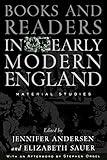Books and Readers in Early Modern England : Material Studies / ed. by Elizabeth Sauer, Jennifer Andersen.
Material type: TextSeries: Material TextsPublisher: Philadelphia : University of Pennsylvania Press, [2012]Copyright date: ©2002Description: 1 online resource (312 p.) : 25 illusContent type:
TextSeries: Material TextsPublisher: Philadelphia : University of Pennsylvania Press, [2012]Copyright date: ©2002Description: 1 online resource (312 p.) : 25 illusContent type: - 9780812217940
- 9780812204711
- Book Industries And Trade -- History
- Book industries and trade -- England -- History -- 16th century
- Book industries and trade -- England -- History -- 17th century
- Books And Reading -- History
- Books and reading -- England -- History -- 16th century
- Books and reading -- England -- History -- 17th century
- Books and reading -- England -- History -- 16th century
- Books and reading -- England -- History -- 17th century
- Great Britain -- Intellectual Life
- LITERARY CRITICISM -- European -- English, Irish, Scottish, Welsh
- Literature and society -- England -- History -- 16th century
- Literature and society -- England -- History -- 17th century
- Literature and society -- England -- History -- 16th century
- Literature and society -- England -- History -- 17th century
- Literature
- LITERARY CRITICISM / European / English, Irish, Scottish, Welsh
- Cultural Studies
- History
- Library Science and Publishing
- Literature
- Medieval and Renaissance Studies
- 028.90942
- online - DeGruyter
- Issued also in print.
| Item type | Current library | Call number | URL | Status | Notes | Barcode | |
|---|---|---|---|---|---|---|---|
 eBook
eBook
|
Biblioteca "Angelicum" Pont. Univ. S.Tommaso d'Aquino Nuvola online | online - DeGruyter (Browse shelf(Opens below)) | Online access | Not for loan (Accesso limitato) | Accesso per gli utenti autorizzati / Access for authorized users | (dgr)9780812204711 |
Frontmatter -- Contents -- Current Trends in the History of Reading -- I. Social Contexts for Writing -- Chapter 1: Plays into Print: Shakespeare to His Earliest Readers -- Chapter 2: Books and Scrolls: Navigating the Bible -- Chapter 3: Theatrum Libri: Burton's Anatomy of Melancholy and the Failure of Encyclopedic Form -- Chapter 4: Approaches to Presbyterian Print Culture: Thomas Edwards's Gangraena as Source and Text -- II. Traces of Reading: Margins, Libraries, Prefaces, and Bindings -- Chapter 5: What Did Renaissance Readers Write in Their Books? -- Chapter 6: The Countess of Bridgewater's London Library -- Chapter 7: Lego Ego: Reading Seventeenth-Century Books of Epigrams -- Chapter 8: Devotion Bound: A Social History of The Temple -- III. Print, Publishing, and Public Opinion -- Chapter 9: Preserving the Ephemeral: Reading, Collecting, and the Pamphlet Culture of Seventeenth-Century England -- Chapter 10: Licensing Readers, Licensing Authorities in Seventeenth- Century England -- Chapter 11: Licensing Metaphor: Parker, Marvell, and the Debate over Conscience -- Chapter 12: John Dryden's Angry Readers -- Afterword: Records of Culture -- List of Contributors -- Index
restricted access online access with authorization star
http://purl.org/coar/access_right/c_16ec
Books and Readers in Early Modern England examines readers, reading, and publication practices from the Renaissance to the Restoration. The essays draw on an array of documentary evidence-from library catalogs, prefaces, title pages and dedications, marginalia, commonplace books, and letters to ink, paper, and bindings-to explore individual reading habits and experiences in a period of religious dissent, political instability, and cultural transformation. Chapters in the volume cover oral, scribal, and print cultures, examining the emergence of the "public spheres" of reading practices. Contributors, who include Christopher Grose, Ann Hughes, David Scott Kastan, Kathleen Lynch, William Sherman, and Peter Stallybrass, investigate interactions among publishers, texts, authors, and audience. They discuss the continuity of the written word and habits of mind in the world of print, the formation and differentiation of readerships, and the increasing influence of public opinion. The work demonstrates that early modern publications appeared in a wide variety of forms-from periodical literature to polemical pamphlets-and reflected the radical transformations occurring at the time in the dissemination of knowledge through the written word. These forms were far more ephemeral, and far more widely available, than modern stereotypes of writing from this period suggest.
Issued also in print.
Mode of access: Internet via World Wide Web.
In English.
Description based on online resource; title from PDF title page (publisher's Web site, viewed 24. Apr 2022)


